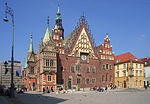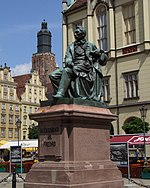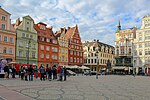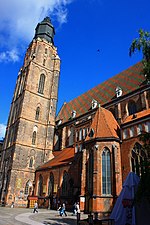Wrocław (Polish: [ˈvrɔt͡swaf] (listen); German: Breslau, pronounced [ˈbʁɛslaʊ] (listen); Lower Silesian: Brassel) is a city in southwestern Poland and the largest city in the historical region of Silesia. It lies on the banks of the River Oder in the Silesian Lowlands of Central Europe, roughly 40 kilometres (25 mi) from the Sudeten Mountains to the south. As of 2022, the official population of Wrocław is 673,923 making it the third largest city in Poland.
Wrocław is the historical capital of Silesia and Lower Silesia. Today, it is the capital of the Lower Silesian Voivodeship. The history of the city dates back over 1,000 years; at various times, it has been part of the Kingdom of Poland, the Duchy of Bohemia, the Kingdom of Hungary, the Habsburg monarchy of Austria, the Kingdom of Prussia and Germany. Wrocław became part of Poland again in 1945 as part of the so-called Recovered Territories, the result of extensive territorial changes of Poland immediately after World War II.
Wrocław is a university city with a student population of over 130,000, making it one of the most youth-oriented cities in the country. Since the beginning of the 20th century, the University of Wrocław, previously Breslau University, has produced nine Nobel Prize laureates and is renowned for its high quality of teaching. Wrocław also possesses numerous historical landmarks, including the Main Market Square, Cathedral Island, Wrocław Opera, the National Museum and the Centennial Hall, which is listed as a UNESCO World Heritage Site. The city is also home to the Wrocław Zoo, which was established in 1865, making it the oldest zoological garden in Poland.
In 1989, 1995 and 2019 Wrocław hosted the European Youth Meetings of the Taizé Community and hosted the Eucharistic Congress in 1997 and the 2012 European Football Championship. In 2016, the city was a European Capital of Culture and the World Book Capital. Also in that year, Wrocław hosted the Theatre Olympics, World Bridge Games and the European Film Awards. In 2017, the city was host to the IFLA Annual Conference and the World Games. In 2019, it was named a UNESCO City of Literature.
Wrocław is classified as a Gamma global city by GaWC. It was placed among the top 100 cities in the world for the Mercer Quality of Living Survey 2015, 2016, 2017, 2019 and in the top 100 of the smartest cities in the world in the IESE Cities in Motion Index 2017 and 2019 report. In February 2021, fDi Intelligence published a report, "Global Cities of the Future 2021/2022", in which Wrocław was classified in 1st place among all medium and small cities in the world.












